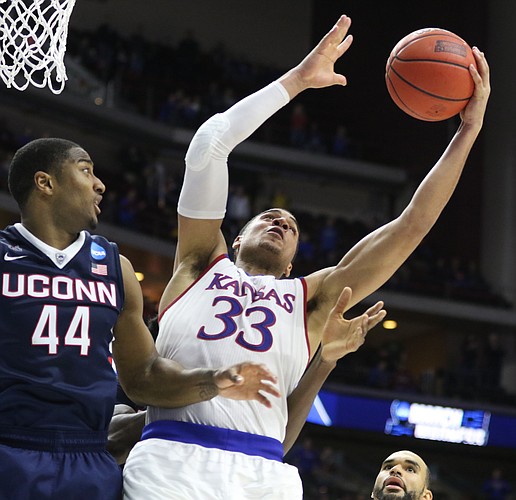One Burning Question: Will Kansas Really Play Small?
Posted by Brian Goodman on November 4th, 2016Perry Ellis was one of the most recognizable players in college basketball over the last two seasons. This isn’t news, but anyone who has ever played in a pickup game could empathize with Ellis’s opponents in how they struggled to contain his lethal combination of footwork, soft touch and accuracy. The jokes about Ellis’s age were every bit as much about what he did with the ball in his hands as they were about his status as a college mainstay in the one-and-done era. As the curtains open on the 2016-17 season, Kansas will miss the All-American’s scoring ability, but something people haven’t mentioned nearly as much is that Ellis’s rebounding ability, while not as prolific, will need to be replaced as well. While the Wichita native was no Thomas Robinson, he did average 6.4 rebounds per game over his final three seasons and finished among the top ten in the conference in that category in each of his last two. The degree to which Kansas’ frontcourt helps Landen Lucas replace that production will strongly impact Bill Self’s efforts to deliver his second National Championship to Lawrence.

Kansas opens the 2016-17 season without a clear-cut complement to Landen Lucas down low. (KUSports.com/Nick Krug)
As our Chris Stone wrote last month, sophomore Carlton Bragg will get the first crack at filling Ellis’ void. At 6’10”, he still needs to prove that he can get into position to retrieve caroms off the glass and initiate Self’s lethal transition attack. Bragg didn’t do a very good job of that in Tuesday’s exhibition, but we’ll find out very quickly against Duke and Indiana if this was just a matter of adjusting to a new role or if it’s something to be more concerned about. If Bragg gets exposed early, don’t be surprised to see transfer Dwight Coleby get the next shot down low. A transfer from Mississippi, Coleby has good experience and, at 240 pounds, a bigger frame than Bragg. The potential drawback with the redshirt junior, though, is that he has been slow to recover from ACL surgery last year. As a coach who values players who make defensive hustle plays and aren’t shy about mixing things up in the post, Self likely won’t have much patience if he senses that Coleby isn’t completely recovered or that he’s not as comfortable testing his body as much as Self thinks he could.
That brings us to seven-foot freshman Udoka Azubuike, and we’ve learned from the last two seasons just how averse Self is to letting young bigs play through mistakes. Azubuike fouled out in just eight minutes of action in the team’s exhibition win earlier this week, suggesting that he could be a long way from being ready to contribute. Azubuike’s opportunities to see extended minutes could also be limited by officials’ points of emphasis this season, which call for referees to closely watch displacement of rebounders and bumping cutters. At 270 pounds, even the softest contact Azubuike makes with a smaller defender could lead to a whistle. If history is any indication, officials will eventually back off of their directives and revert to the usual ways they’ve called games, but in the meantime it isn’t hard to see the physical Azubuike becoming a victim of those circumstances. Another freshman, Mitch Lightfoot could see some minutes, but at 6’8″ and 210 pounds, it’s tough to see him pick up the slack on the glass until he gains more strength.
If Self is adamant about playing his typical two-in, three-out lineup, he has plenty options at the post positions, but no single clear-cut option. That’s one of the main reasons why we’ve seen Self pay more lip service than usual to the idea of playing small this season; If a second traditional big man isn’t going to give the Jayhawks the rebounding help they need, eschewing the battle on the glass in favor of an extra floor-spacer like Svi Mykhailiuk or Lagerald Vick could ultimately be a net positive and maximize Kansas’ championship potential. On the other hand, old habits die hard, so despite Self saying that he’s aiming to play his typical two-big lineup for 25-30 minutes per game and go small the rest of the time, don’t be surprised if the prototypical post players soak up the overwhelming majority of minutes at the 4 and 5 spots like we’ve come to expect.











































